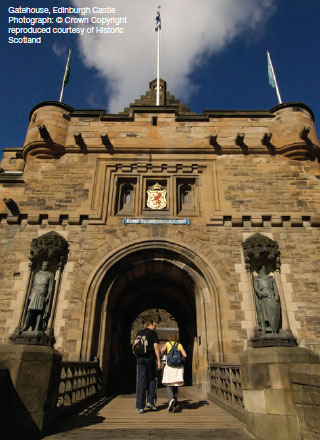Our Place in Time: the Historic Environment Strategy for Scotland
A high-level framework which sets out a 10-year vision for the Scotland's historic environment.
D - Value: Share and Celebrate
Strategic Priorities
Enhance participation through encouraging greater access to and interpretation and understanding of the significance of the historic environment.
Continue to develop a broad-ranging approach to learning to grow understanding and active participation across all groups in society.
Support historic environment tourism and encourage access by making full use of our heritage assets to promote Scotland to domestic and international audiences.
In order to share and celebrate our historic environment as widely as possible we must continue to build on our successes to date and find new and innovative ways of interpreting and presenting our heritage to the people of Scotland and beyond. Encouraging wide-ranging access and adopting a broad learning and engagement approach to growing understanding and promoting active participation will help deliver this key aim. We want to see people value the historic environment as an important community resource. This can mean visiting our iconic sites - but we want more people to be able to gain an understanding and appreciation of all aspects of our historic environment.
Providing formal and informal education about the historic environment enables people of all ages to understand, enjoy and appreciate it, incentivising them to care for it and take an active role in its preservation and management. Encouraging communities to engage with their historic environment leads to a sense of ownership and empowerment at the local level, which builds community cohesion, encourages active citizenship, and acts to prevent the future cost of damage or neglect.
The historic environment is a valuable resource for residents and visitors of any nationality, age or ability.
Response made to equalities survey, January 2014
Key aim: sharing and celebrating the richness and significance of our historic environment, enabling us to enjoy the fascinating and inspirational diversity of our heritage.
Providing training and support for volunteers in the skills and knowledge required to understand, record and promote the historic environment brings direct tangible results that multiply the efforts of public, private and third sector organisations. Involving people in their historic environment encourages an understanding of national identity, provides enjoyment, and encourages wellbeing. Many organisations are involved in the delivery of formal education, and in community and volunteering activities around the historic environment. Some have strong strategies in place guiding their work. Going forward, good practice should be shared, new partnerships built, and the best possible use made of complementary resources.
As one of the biggest and most resilient business sectors across the world, tourism has a huge role to play in this process, and the historic environment is a key aspect of the Scottish tourism industry - providing both visitor attractions and employment in rural and urban settings and across the country.
Promoting Scotland
Our historic environment is a key driver of tourism and of Scotland's international reputation:
- The National Brands Index (2012) shows that Scotland retains a strong reputation for tourism and heritage. Out of 50 nations, Scotland is ranked 13 for tourism and 12 for being rich in historic buildings and monuments.
- The Scottish Household Survey shows that 28% of adults had visited a historic or archaeological site in the 12 months prior to 2012.
- Attitudes to heritage are extremely positive with more than 9 out of 10 saying that historic features are an important part of the identity of our villages, towns and cities.

Gatehouse, Edinburgh Castle
Photograph: © Crown Copyright reproduced courtesy of
Historic Scotland
The historic environment is a key aspect of the Scottish tourism industry.
Contact
There is a problem
Thanks for your feedback